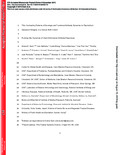Contrasting patterns of serologic and functional antibody dynamics to Plasmodium falciparum antigens in a Kenyan birth cohort
Abstract
IgG antibodies to Plasmodium falciparum (Pf) are transferred from the maternal to fetal circulation during pregnancy, wane after birth, and are subsequ ently acquired in response to natural infection. We examined the dynamics of malaria antibody responses of 84 Kenyan infants from birth to 36 months of age by i) serology, ii) variant surface antigen (VSA) assay, iii) 34 growth inhibitory activity (GIA) and iv) invasion inhibition as says (IIA) specific for merozoite surface protein 1 (MSP1) and sialic acid dependent invasion pathway. Maternal antibodies in each of these four categories were detected in cord blood and decreased to their lowest level by approximately 6 months of age. Serologic antibodies to three
pre-erythrocytic and ten blood stage antigens subsequently increased, reaching peak prevalence by 36 months. I contrast,
sensitized to Pf in utero, defined by cord blood lymphocyte recall responses to malaria antigens, acquired antimalarial antibodies at the same rate as those who were not sensitized in utero, indicating that fetal exposure to malaria antigens did not affect subsequent infant antimalarial responses. Infants with detectable serologic antibodies at 12 months of age had an increased risk of Pf infection during the subsequent 24 months. We conclude that serologic measures of antimalarial antibodies by children ≤36 months of age represent biomarkers of malaria exposure rather than protection, and that functional antibodies develop after 36 months of age in this population.

